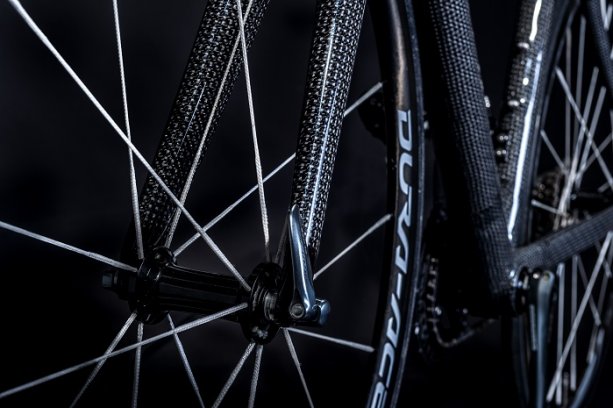
Shatterproof safety for cyclists
By marrying carbon with Dyneema, impact energy absorption can be increased by up to 100% while removing the risk of splintering.

28th October 2016
Innovation in Textiles
|
The Netherlands
DSM Dyneema presented its new lightweight performance Dyneema Carbon hybrid composites at the K plastics and rubber trade fair, which took place from 19-26 October in Dusseldorf, Germany.
Ongoing projects were highlighted demonstrating how Dyneema Carbon can help improve the performance of sports and automotive motorsports products that currently rely on pure carbon composites. The applications include racing bikes, hockey sticks, tennis rackets and golf clubs with a better feel through reduced vibration thanks to using carbon fibre reinforcements.

According to Roel Marissen, DSM Dyneema scientist and part-time professor at Delft University of Technology, the popularity of carbon fibre is easy to explain, as it is stiff, lightweight and easy to mould. “But it’s not so good at handling impact,” he notes. Carbon also splinters when it breaks, which can cause injuries. By marrying carbon with Dyneema, impact energy absorption can be increased by up to 100% while removing the risk of splintering, according to the company. Dyneema Carbon hybrid composites are also said to be lighter, less brittle and more vibration dampening than pure carbon composites.
One project presented at the K Trade Fair was a prototype of a high-performance bike. The Dyneema Carbon frame is said to provide for a ride that is both more comfortable (reduced vibration) and safer (increased ductility), when compared to pure carbon composites, according to the manufacturer.
The spokes, made from a Dyneema braid, aim to provide more lightweight strength than steel spokes – so less energy is needed to accelerate and climb. Working with several brands on development projects, DSM Dyneema expects to have the first commercially available bikes in 2018.

Another cycling-related project is an aerodynamic seat for world champion hand cyclist Laura de Vaan, who recently went on to win two medals at the Rio Paralympics 2016. “I remember when I first used the bike for the time trials in Rio, it felt very solid on the road. I pointed it and it went in that direction. Wind was not of influence. And I knew it was impossible to break.”
“Fifteen times stronger than steel but floats on water, Dyneema fibre has long been used to moor oilrigs, sail ships, stop bullets and repair human ligaments,” says the company. “As a fabric component, it’s becoming increasingly popular with high-performance sports apparel and athletic sportswear – from mountain climbing to motorcycling.”
Now as part of a hybrid composite, Dyneema says it can bring its lightweight strength to products currently using pure carbon composites – covering everything from hockey sticks to racing bikes to basically anything which moves at speed. Dyneema is also currently being applied to new non-carbon composites that can be tailored to other specific performance-enhancing needs.

Business intelligence for the fibre, textiles and apparel industries: technologies, innovations, markets, investments, trade policy, sourcing, strategy...
Find out more